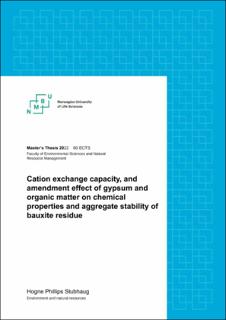| dc.contributor.advisor | Mulder, Jan | |
| dc.contributor.advisor | Okkenhaug, Gudny | |
| dc.contributor.advisor | Capobianco, Vittoria | |
| dc.contributor.author | Stubhaug, Hogne Phillips | |
| dc.date.accessioned | 2022-11-14T10:18:36Z | |
| dc.date.available | 2022-11-14T10:18:36Z | |
| dc.date.issued | 2022 | |
| dc.identifier.uri | https://hdl.handle.net/11250/3031638 | |
| dc.description.abstract | Bauksittavfall (BR) er overskotsprodukt frå ekstrahering av alumina frå bauksittmalm. Bak kvart tonn alumina produserast det 1-2 tonn bauksittavfall, og verdas største aluminaraffineri er Hydro Alunorte, som ligg ved byen Belém, i nordaustlege Brasil. Bauksittavfall er svært alkalisk (pH 11-13), salint og sodisk, og det inneheld høge verdiar av jern, aluminium og sporelement. Målet med denne oppgåva var å undersøke kunnskapshol rundt korleis betre BR som eit medium for plantevekst, då økosystem-restaurering er føreslått som den beste løysinga for å forbetre bauksittavfallsdeponi.
Denne oppgåva fokuserte på tre spesifikke utfordringar: 1. Vurdering av kationbyttekapasitet (CEC) i BR, gjennom samanlikning av ein mykje brukt metode kor ammoniumacetat (NH4OAc) ekstraherer kation i BR, og ein metode som belagar seg på at kaliumklorid (KCl) bytar ut adsorbert ammonium (NH4+) etterfølgt av NH4OAc-tilsettinga. 2. Forbetringseffekt på plantevekst i eit kolonneforsøk. Bauksittavfall blei tilsett gips og lokalt organisk materiale: Avfallsproduktet frå Açai -produksjon og matavfall. Vatn blei tilført kolonnene i ei utlekkingserie for å redusere pH, elektrisk leiingsevne og saltinnhald, før tilsetning av raigrasfrø (Lolium perenne). Deretter følgde eit vekstforsøk over fem veker. 3. Aggregatstabilitet av BR med dei ulike jordbetringsmidla, i laboratoriekolonner og i feltprøver frå Hydro Alunorte.
Kationbyttekapasiteten blei frå NH4OAc-ekstrahering blei bestemt til om lag 250 meq/100g, medan den var om lag 35 meq/100g med den KCl-utbyttbare metoden. Sistnemnde vart betrakta som den beste representasjonen av den sanne CEC, medan NH4OAc overestimerte den. Utlekkingsforsøket førte EC <4 dS/m og pH blei redusert til 11.9 med 10% gips og 7.5 med 10% gips + 5% matavfall. 10% gips var også mest effektiv i å redusere saltinnhald, med ein SAR = 6.1, og gras viste best vekst i denne behandlinga. Frå feltprøvene førte gips også til signifikant forbetra aggregatstabilitet samanlikna med ubehandla BR, og det var inga signifikant forskjell mellom 5, 10 og 15% gips. Gips med Açai gav litt betre stabilitet enn når berre gips var tilsett.
Basert på funna i denne masteroppgåva og tilgjengelegheita av Açai i denne regionen av Brasil, kan gips + Açai vere ein lovande kombinasjon, spesielt dersom avfall frå Açai blei behandla i forkant av tilsetning, for å auke tilgjengelegheita av karbon for mikroorganismar, som ville ført til ein rikare jordfauna og større pH-senking. Açai+ gips bør derfor bli ytterlegerare utforska, i tillegg til langtidsverknaden i felt. | en_US |
| dc.description.abstract | Bauxite residue (BR) is the waste product in alumina extraction from bauxite. Behind every tonne alumina, 1-2 tonnes BR is generated, and the world’s largest alumina refinery is Hydro Alunorte, Brazil. Bauxite residue is highly alkaline (pH 11-13), saline and sodic, and it contains high amounts of iron and aluminium and trace elements. The aim of this thesis was to investigate knowledge gaps around how to improve BR as a plant-growth medium, as ecosystem restoration has been pointed out to be the most promising strategy for remediating BR disposal areas.
The thesis focused on three specific challenges: 1. Assessment of cation exchange capacity (CEC) in BR, by comparing the common method; ammonium acetate (NH4OAc) extractable cations and another method which includes a second step where potassium chloride (KCl) replaces adsorbed ammonium (NH4+) from the NH4OAc. 2. Amendment effect on plant performance in a column study. Here, BR was amended with 0, 5, and 10 % gypsum and 0 and 5% locally derived organic matter: Waste from Açai berry production and food waste. Water was added to the columns in a leachate series to reduce pH, electrical conductivity, and sodicity, before seeds of rye grass (Lolium perenne) were planted. The growth was observed for five weeks. 3. Aggregate stability on amended and unamended BR with both samples from the columns and field-samples from Hydro Alunorte.
The determined CEC by NH4OAc extraction was about 250 meq/100g, while it was about 35 meq/100g by the KCl exchangeable method. The latter was considered to better represent the true CEC in BR, while NH4OAc highly overestimated it. The leaching experiment resulted in a reduction of the EC<4 dS/m and a pH of 8.9 with 10% gypsum and 7.5 with 10% gypsum and 5% food waste. 10% gypsum was also most effective in reducing sodicity, and grass performed best in this treatment, followed by 10% gypsum and 5% Açai waste. Gypsum application resulted in significantly improved aggregate stability compared to unamended BR, and it was no significant difference between 5%, 10% or 15% gypsum added. Gypsum with Açai waste resulted in slightly better stability then when only gypsum was applied.
Based on the findings in this study and the availability of Açai in this region of Brazil, Gypsum + Açai waste could be a promising amendment, especially if the Açai waste was composted to a certain degree before augmenting, to provide more easily available carbon and nutrient sources, which could lead to richer soil fauna and greater pH-reducing effect. The effect of Açai + gypsum should therefore be further investigated, as well as its long-term effect in the field. | en_US |
| dc.description.sponsorship | Norsk Hydro ASA | en_US |
| dc.language.iso | eng | en_US |
| dc.publisher | Norwegian University of Life Sciences, Ås | en_US |
| dc.rights | Attribution-NonCommercial-NoDerivatives 4.0 Internasjonal | * |
| dc.rights.uri | http://creativecommons.org/licenses/by-nc-nd/4.0/deed.no | * |
| dc.title | Cation exchange capacity, and amendment effect of gypsum and organic matter on chemical properties of and aggregate stability of bauxite residue | en_US |
| dc.type | Master thesis | en_US |
| dc.description.localcode | M-MINA | en_US |

